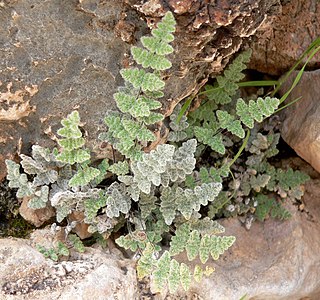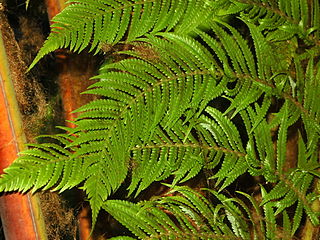Related Research Articles

Sir William Jackson Hooker was an English botanist and botanical illustrator, who became the first director of Kew when in 1841 it was recommended to be placed under state ownership as a botanic garden. At Kew he founded the Herbarium and enlarged the gardens and arboretum. The standard author abbreviation Hook. is used to indicate this person as the author when citing a botanical name.
Frond dimorphism refers to a difference in ferns between the fertile and sterile fronds. Since ferns, unlike flowering plants, bear spores on the leaf blade itself, this may affect the form of the frond itself. In some species of ferns, there is virtually no difference between the fertile and sterile fronds, such as in the genus Dryopteris, other than the mere presence of the sori, or fruit-dots, on the back of the fronds. Some other species, such as Polystichum acrostichoides, or some ferns of the genus Osmunda, feature dimorphism on a portion of the frond only. Others, such as some species of Blechnum and Woodwardia, have fertile fronds that are markedly taller than the sterile. Still others, such as Osmunda cinnamomea, or plants of the family Onocleaceae, have fertile fronds that are completely different from the sterile.

Franz Andreas Bauer was an Austrian microscopist and botanical artist. The standard author abbreviation F.A.Bauer is used to indicate this person as the author when citing a botanical name.
Thomas Moore was a British gardener and botanist. An expert on ferns and fern allies from the British Isles, he served as Curator of the Society of Apothecaries Garden from 1848 to 1887. In 1855 he authored The Ferns of Great Britain and Ireland. The standard author abbreviation T.Moore is used to indicate this person as the author when citing a botanical name.
Carl Frederik Albert Christensen was a Danish systematic botanist. He graduated in natural history from the University of Copenhagen under professor Eugenius Warming. He was then a school teacher in Copenhagen, and later superintendent at the Botanical Museum. He was a specialist in ferns and published a catalogue of the World's Pteridophytes, Index Filicum. In addition, he authored a three-volume work on the history of botany in Denmark.
Rodolfo Emilio Giuseppe Pichi-Sermolli was an Italian botanist.

Zealandia pustulata is a species of fern native to eastern Australia and New Zealand. It is commonly referred to as kangaroo fern because of its mature leaves tend to resemble the shape of a kangaroo foot. It is also referred to as hound's tongue, and as kōwaowao and pāraharaha in Māori.
Ctenopteris is a defunct genus of ferns in the family Polypodiaceae. The name is derived from two Greek words: ktenos, "comb", and pteris, "fern".

John Smith (1798–1888) was a British botanist who was the first curator at Royal Botanic Gardens, Kew, starting in 1841. He had first been employed at the gardens as a stove boy in 1822. Along with the directors, Sir William Jackson Hooker and Sir Joseph Hooker, he oversaw the conversion of the gardens from private royal gardens to public gardens when Queen Victoria converted them, possibly saving them from oblivion. He further prevented the gardens from catastrophic decline during the late 19th century when they were neglected in funding priorities. According to the Kew website, "It is significant that when stove-boy-Smith arrived at Kew, 40 species of fern were grown but when Curator Smith retired, there were 1,084."
Index Filicum is a discontinued series of botanical indices on ferns, started by Carl Christensen in 1906 and continued in the form of seven supplements by Christensen and other authors until 1997. As of supplement 5, the index also covered lycophytes and horsetails. There was an earlier work of the same name by Thomas Moore, published in eight volumes between 1857 and 1863.

Cheilanthoideae is one of the five subfamilies of the fern family Pteridaceae. The subfamily is thought to be monophyletic, but some of the genera into which it has been divided are not, and the taxonomic status of many of its genera and species remains uncertain, with radically different approaches in use as of December 2019.

Cibotium regale, common name royal cibotium or royal Mexican tree fern, is a species of tropical tree fern belonging to the family Cibotiaceae.

Myriopteris tomentosa, formerly known as Cheilanthes tomentosa, is a perennial fern known as woolly lipfern. Woolly lipfern is native to the southern United States, from Virginia to Arizona and Georgia, and Mexico.

Myriopteris lanosa, the hairy lip fern, is a moderately-sized fern of the eastern United States, a member of the family Pteridaceae. Its leaves and stem are sparsely covered in hairs, but lack scales, hence its common name. One of the cheilanthoid ferns, it was usually classified in the genus Cheilanthes until 2013, when the genus Myriopteris was again recognized as separate from Cheilanthes. It typically grows in shallow, dry, soil, often in rocky habitats.

Myriopteris alabamensis, the Alabama lip fern, is a moderately-sized fern of the United States and Mexico, a member of the family Pteridaceae. Unlike many members of its genus, its leaves have a few hairs on upper and lower surfaces, or lack them entirely. One of the cheilanthoid ferns, it was usually classified in the genus Cheilanthes as Cheilanthes alabamensis until 2013, when the genus Myriopteris was again recognized as separate from Cheilanthes. It typically grows in shade on limestone outcrops.
Myriopteris allosuroides is a moderately-sized fern of Mexico, a member of the family Pteridaceae. Unlike many members of its genus, its rachides are grooved on the upper surface and largely free of hairs or scales. One of the cheilanthoid ferns, it was usually classified in the genera Cheilanthes or Pellaea until 2013, when the genus Myriopteris was again recognized as separate from Cheilanthes. It typically grows on dry, rocky slopes over acidic, particularly basaltic, rock.
Argyrochosma chilensis is a fern endemic to the Juan Fernández Islands off the coast of Chile. It has leathery, thrice-divided leaves with dark brown axes; the leaves are coated with white powder below. First described as a species in 1853, it was transferred to the new genus Argyrochosma in 1987, recognizing their distinctness from the "cloak ferns".

Myriopteris aurea, the golden lip fern or Bonaire lip fern, is a moderately-sized fern native to the Americas, a member of the family Pteridaceae. Unlike many members of its genus, its leaf is only modestly dissected into lobed leaflets (pinnae), which are hairy both above and below. One of the cheilanthoid ferns, until 2013 it was classified in the genus Cheilanthes as Cheilanthes bonariensis, when the genus Myriopteris was again recognized as separate from Cheilanthes. It typically grows on dry, rocky slopes, and ranges from Mexico, where it is common and widespread, and the southwestern United States south and east through Central and South America as far as Chile and Argentina.

Argyrochosma microphylla, the small-leaf false cloak fern, is a species of fern native to New Mexico, Texas and northern Mexico. It grows on limestone rocks and cliffs, and has finely-divided leaves with small leaf segments, often folded in half when dry, which lack the white powder present on the leaf underside of many related species. First described as a species in 1869, it was transferred to the new genus Argyrochosma in 1987, recognizing their distinctness from the "cloak ferns".
References
- Nature.com
- Phylogenetics and biogeography of the neotropical fern genera Jamesonia and Eriosorus (Pteridaceae) by Patricia Sánchez-Baracaldo